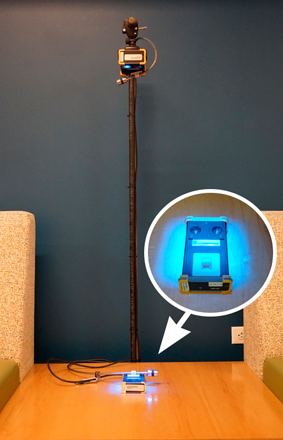Consumer
Li-Fi – A Bright Future for Home Networks

At CableLabs, we are continually researching new methods of in-home wireless network distribution, and one exciting new contender is Li-Fi.
What is Li-Fi?
Li-Fi is the modulation of a free-space beam of light in order to transmit a signal. It can be thought of as analogous to Wi-Fi, just in a much higher frequency band (430 – 770 THz vs. 2.4 GHz). We’ve actually been using this same basic concept for over 100 years, in the form of Morse code being transmitted from ship to ship via signal lamps.
The Shannon–Hartley theorem allows us to calculate the maximum bitrate of a communications channel with a specific bandwidth. Since capacity increases with bandwidth, we can immediately see the vast potential of Li-Fi, which has ~340 THz to work with in the visible light frequencies. Compare that with Wi-Fi, which has less than 1 GHz available and is able to provide over a gigabit per second, and you can see the potential for ultra-high speed in-home networks. As virtual and augmented reality achieve widespread adoption, these ultra-high speeds will become mandatory.
To give you an idea of just how large a difference this increase in bandwidth is, it’s close to the same difference between the mass of the Earth and the Sun!
Where are we going?
The ideal product is a Li-Fi enabled light bulb in the same form factor that consumers are used to now – and with the same ease of installation. Li-Fi could be a viable solution to improving the coverage and reliability of a home network by reusing existing light fixtures. Just screw the bulb in and you’ve expanded your network.
The other side of the connection is the endpoint device, and a number of consumer device manufacturers are beginning the process of integrating Li-Fi. Apple is exploring adding Li-Fi to their mobile devices, which is a natural product evolution, as the majority of smartphones already contain the two things needed for Li-Fi, a light detector (the camera) and a light emitter (the camera flash).
Where are we today?
CableLabs has fully functioning prototypes of a single-channel Li-Fi system, which have proved to achieve data rates of around 300 Mbps. It is free from Wi-Fi interference and simple to use. Currently the devices need to be directly in-line with each other, so research into improving the signal-to-noise ratio (SNR) is needed for us to achieve omnidirectional Li-Fi.
We’ve also done extensive research into the necessary backhaul systems that will make Li-Fi a useful reality, such as next-generation powerline networking, which uses your existing home electrical wiring as a network. By networking the Li-Fi bulbs together, you can achieve seamless, whole-home coverage. Anywhere there is light, there is connectivity.
The cable industry, with the introduction of DOCSIS 3.1 and beyond, continues to increase Internet connection speeds. These speeds are currently beyond what any current-generation in-home wireless system can handle, so research into technologies like Li-Fi will play a vital part in ensuring customers are able to fully utilize their connection.
Josh Redmore is the Lead Architect in Wireless Network Optimization group at CableLabs.
Follow him on Twitter.



